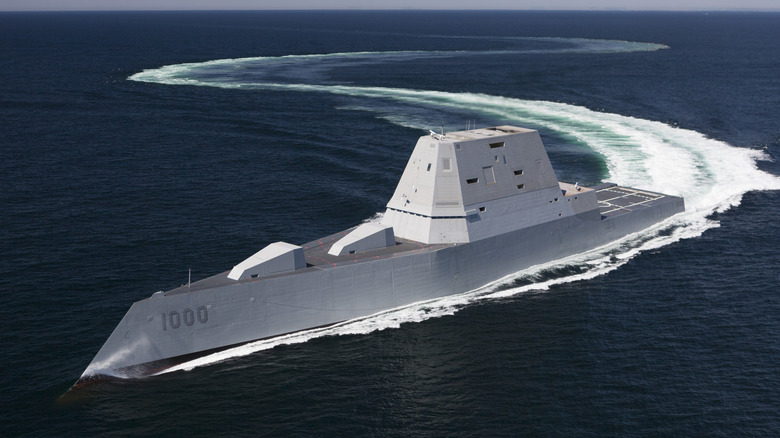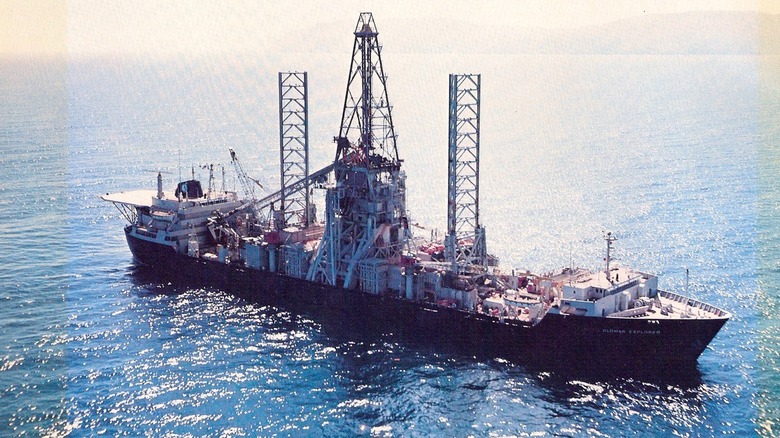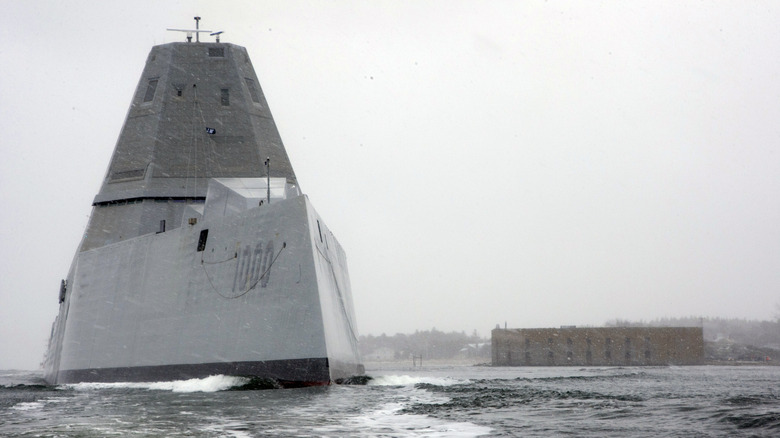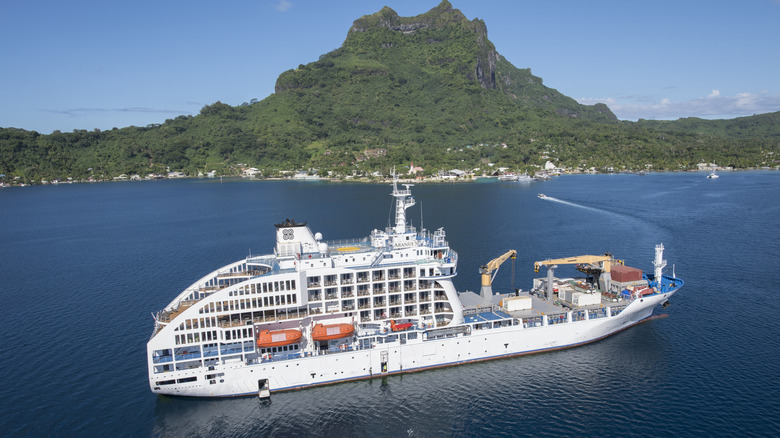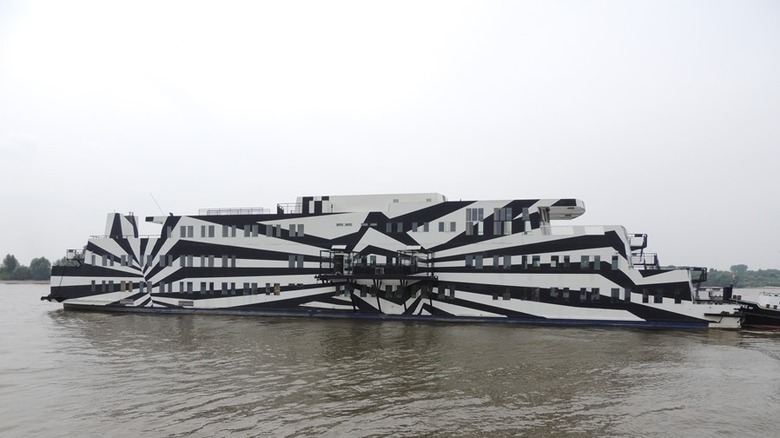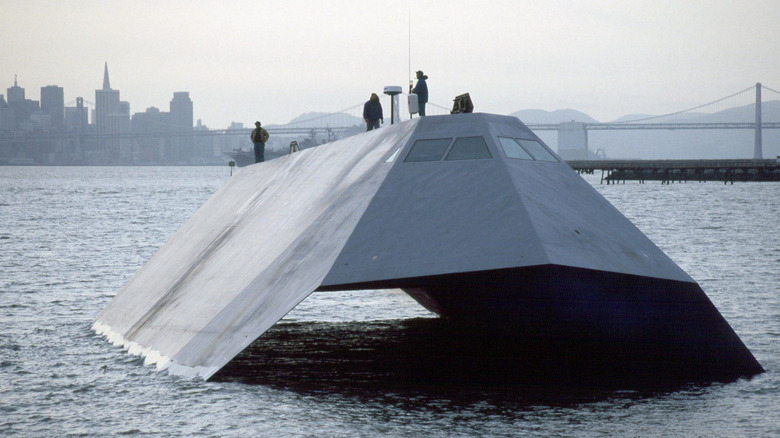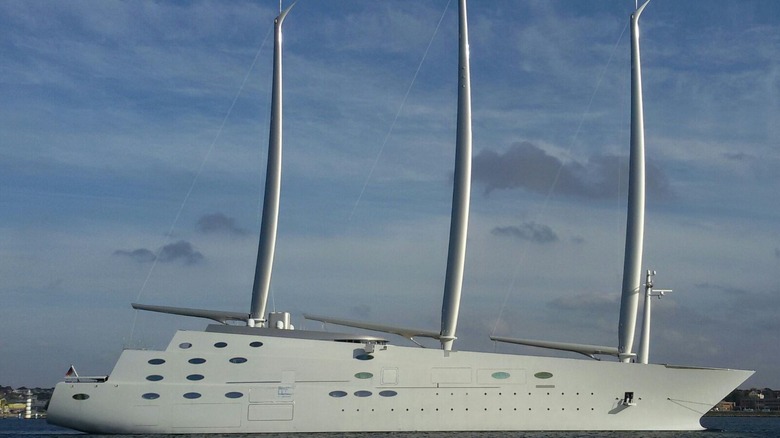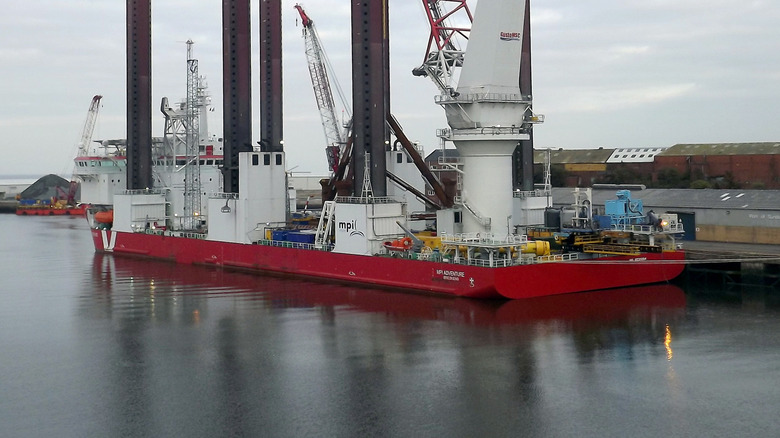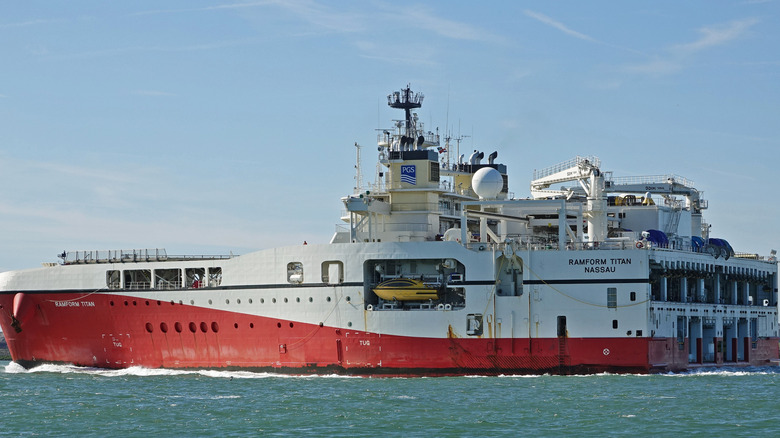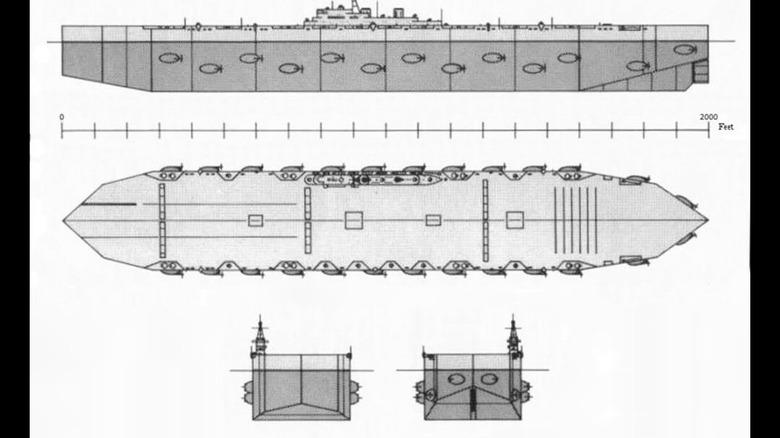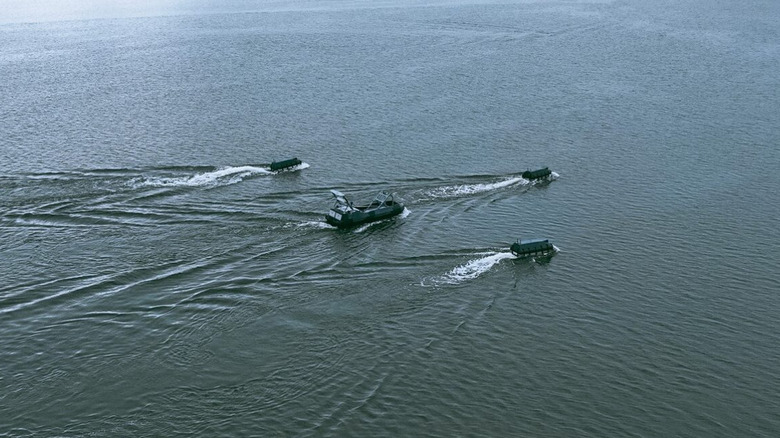10 Of The Strangest Ships In The World
Ships conjure the romance of sailing the seven seas. Since time immemorial, people have put to sea in some of the most graceful machines humanity has ever built. From Greek triremes cutting through the water with oars and sails to Polynesian outriggers navigating by sun, moon, and stars to speedy corvettes and massive aircraft carriers that can turn on a dime, some of our greatest creations have been built to tame the Earth's oceans and go where no one has gone before. Ships are the stuff dreams –- and legends –- are made of.
But form follows function, and some ships have peculiar functions. For instance, the medieval pirate captain Jeanne de Clisson set out in a fleet of vessels painted black with blood red sails for one purpose: to seek revenge for her husband's execution. About 500 years later, the first ironclad battle in history, between the U.S.S. Monitor and the C.S.S. Virginia, saw two ships that looked more like reinforced metal bunkers than the graceful sailing ships typical of their age engage in a duel. The U.S. Navy's first aircraft carrier was a converted coal transport with a completely flat flight deck installed above her entire superstructure, resulting in a strange, top-heavy appearance.
Other ships have odd appearances for a variety of reasons. Some are scientific research vessels whose form is dictated entirely by their missions. Others are construction ships used to build structures at sea, such as oil platforms and wind turbines. And as we've already seen, the needs of war can lead to shapes never seen before on the world's oceans. What follows is a list of 10 of the strangest ships in the world.
Hughes Glomar Explorer
The sea can be a cruel and fickle ally, as the crew of the Soviet Union's nuclear missile submarine K-129 found out. Nobody knows for sure what happened when the sub went missing in 1968, but the watery deep that hid the craft from enemy eyes would become a grave. This set off a race to find the boat — a race that the United States won. Using sophisticated acoustics and a spy ship equipped with state-of-the-art sonar, computers, and cable-controlled scout pods, the U.S. Navy located K-129's final resting place, 3 miles deep, and the CIA set out to raise it. This is the story of how Howard Hughes and the CIA stole a Soviet nuclear submarine.
The CIA enlisted Hughes' help to create a cover story for a one-of-a-kind ship called the Hughes Glomar Explorer, which the CIA would build to raise the K-129. Hughes's famously reclusive nature was an asset to the project, allowing the ship to be built away from the eyes of the public and the press, who assumed it was another of the eccentric billionaire's secret personal projects. Alleged to be a deep-sea mining research craft, the ship was actually a CIA vessel equipped with a gigantic claw designed to raise K-129 from the seabed and lift it through an opening in the ship's hull. Against long odds, the Hughes Glomar Explorer raised a large part of the sub.
With the sub came the bodies of some of the crew. The USA and the USSR may have been enemies, but sailors have mutual respect for their adversaries. The K-129's crew members were given a burial at sea, the film of which was given to the Soviets decades later as a gesture of goodwill and closure for the crews' loved ones.
USS Zumwalt
The changing mission of the U.S. Navy after the end of the Cold War would give birth to the USS Zumwalt, the largest destroyer ever built and the first of the stealthy Zumwalt class, of which only three would be produced out of 32 originally planned. In the end, cost overruns and technical problems led the U.S. to cancel the $22 billion stealth ship program. The resulting ships, however, sport what is arguably the most striking appearance of any active ships in the Navy due to their stealth characteristics. The technology below their stealthy exterior is just as advanced.
The USS Zumwalt's mission resulted in part from the decommissioning of the Navy's World War II-era battleships after the Cold War ended. The U.S. Marine Corps wanted ships with the old battleships' firepower to support their mission of landing on enemy shores. The Navy, meanwhile, wanted the new ships to have a lower radar cross-section to make them less visible to the enemy. Both criteria resulted in the Zumwalt's amazing design. The Zumwalt's tumblehome hull slopes downward and outward toward the waterline, and the shape continues right up through its superstructure, giving the ship its remarkable angular appearance. This shape helps to deflect radar waves, a function enhanced by its composite superstructure, smooth surfaces, and integrated multifunction mast.
The heart of the ship is its pair of 155 mm Advanced Gun Systems (AGS), which can fire a smart projectile more than 80 miles with pinpoint precision. However, the projectiles cost up to $800,000 apiece, making them too expensive to fire. The ships themselves ballooned in cost to around $8 billion each, and were plagued with technical and mechanical issues. Ultimately, they were probably just a bit too far ahead of their time, technologically.
Aranui 5
People have been hitching rides on freighters for decades, if not centuries, but the Aranui cruise line takes the concept to new heights with ships that are half cargo ship and half luxury cruise ship. The resulting hybrid vessels, like the Aranui 5, offer a striking profile in which the back half of the ship looks like a cruise liner while the front half looks like a cargo ship, complete with deck cranes. The Aranui 5 offers 14-day cruises from Tahiti to French Polynesia, swaddling passengers in tropical luxury while also serving as a supply ship.
At 413 feet, the Aranui 5 is classified as a small ship. It features 103 cabins that can accommodate 230 passengers. In keeping with the heritage of the ship's owners and much of her crew, the cabins are decorated with Polynesian designs and furnishings. The cabins include a mix of staterooms and suites with balconies, as well as a few dormitory-style cabins. Amenities include scaled-down versions of what you would find on a larger cruise ship, including three bars, an outdoor swimming pool, a restaurant that serves all three meals, a gym, a spa, a library, and even a tattoo studio. Conference rooms host presentations on the ship's ports of call. The Aranui 5 also carries 3,000 tons of freight in its role as a supply ship.
Reviewers generally praise the Aranui 5's unique take on cruising. CruiseCritic.com says it "takes passengers to the heart of one of the world's most cinematically beautiful destinations" while immersing them in Polynesian culture. It notes that cruise fans looking for Broadway-style shows and unlimited meal times might be disappointed. A Conde Nast review hits many of the same high points, calling it "a cruise like few others in the world."
Sans Vitesse
The Sans Vitesse, strictly speaking, isn't actually a ship. Rather, it's an accommodation barge, which is a non-self-propelled vessel designed to house workers in coastal or offshore jobs. However, since it's a manned vessel, colloquially speaking, it's fair to call it a ship. What makes the Sans Vitesse stand out from other craft of its type is its wild, black-and-white, First World War-style dazzle camouflage scheme. The barge's owner is Chevalier Floatels, and its website doesn't explain why the Sans Vitesse is painted like it's trying to dodge German U-boats, but it certainly gives it a striking and unique appearance.
So, what is dazzle camouflage? It was invented during World War I to try to stem the flood of shipping losses due to German submarines. A British Royal Navy volunteer borrowed the idea from nature, where animals like zebras and tigers use stripes to confuse predators or prey visually. The idea was that a German officer glimpsing the ship through a periscope would have difficulty determining which end was which, as well as the angle at which his target was moving. The success of the scheme was hard to determine, but the concept would be used again to a limited extent in World War II.
The Sans Vitesse was once moored for two years in the harbor of the town of Lerwick in Scotland's Shetland Islands to house workers building a gas plant. There, the ship's zebra paint scheme wasn't appreciated as much as it was by the Great War-era Royal Navy. Townsfolk considered it an eyesore and were undoubtedly relieved when it moved on to its next port of call.
Sea Shadow
Lockheed's F-117 "invisible" stealth jet changed the nature of aerial warfare when it made its combat debut during the invasion of Panama in 1989 and Operation Desert Storm the following year. Inspired by the success of their jet, engineers at Lockheed wondered if the concept could be taken out to sea. Initially hoping to build a sonar-evading submarine, they changed course when they learned about a fast, catamaran-style ship prototype called the Small Water Area Twin Hull, or SWATH. This vessel's design would become the model on which the Sea Shadow stealth ship would be built.
The Sea Shadow looked like the F-117 in ship form, with radar-deflecting angular surfaces and jet-black, radar-absorbing, iron ferrite surface material. Perched high above the water on its blade-shaped twin catamaran hulls that angled downward toward the water at 45 degrees, it looked like some sinister winged beast skimming along the waves. It would have been right at home in the Batcave. The goal was to make the Sea Shadow invisible to the Soviet Union's X-band radar. The engineers hoped the Sea Shadow could evade Soviet reconnaissance satellites and sophisticated new missiles. They also hoped to test the durability of the iron-based radar-absorbing coating in a saltwater environment.
Sea trials for the 156-foot vessel and its four-person crew began in 1981. After some initial mechanical glitches, the Sea Shadow underwent several nighttime trials (to keep it hidden from the public) in 1985 and 1986. Ultimately, development of the ship was shelved, but some of its technical concepts went on to be used in ships like the Zumwalt-class destroyers. The Sea Shadow stealth boat went up for auction in 2012.
Sailing Yacht A
The specs of the world's largest sail-assisted yacht are amazing enough on paper, but its appearance is like something from another world in that its a gigantic, multi-level wedge-shaped ship with curving masts. It is among a group of weird boats that will change the way you think about water travel. The yacht's striking form was drafted by industrial designer Philippe Starck and built for Russian billionaire Andrey Melnichenko. Dykstra Naval Architects translated the design into reality. The Nobiskrug yacht builders of Germany delivered the vessel in 2017.
At the time of her construction, the boat was one of only four sailing yachts to exceed 100 meters (328 feet) in length, and it did so by quite a bit at a total length of 468.5 feet. When not under sail, the Sailing Yacht A is motivated by twin diesel engines from MTU, a division of Rolls-Royce Power Systems. The ship's top speed is 21 knots, above average for its class. Its range is over 5,000 nautical miles. Gross tonnage equals 12,558. The hull is steel, while the superstructure incorporates high-tech materials like carbon fiber. The yacht requires a crew of 54 to sail her.
The rotating masts are made of carbon fiber and support almost 40,000 square feet of sails. A crow's nest in one of the masts is reached via an elevator. The yacht even carries a three-man submarine. After the Russian invasion of Ukraine, Andrey Melnichenko became one of many Russian oligarchs targeted by Western sanctions. Italy subsequently seized the Sailing Yacht A and sequestered it in the port of Trieste.
MPI Adventure and MPI Discovery
Some of the most interesting ship forms result from the requirements of marine construction. These are definitely ships where form follows function, with aesthetics playing little or no role. This results in some truly strange-looking ships, and the twin ships MPI Adventure and MPI Discovery fit this category. These ships are used in offshore wind farm installation, and each is equipped with six jack-up legs to aid in that mission. Under sail, the legs protrude high above the broad deck like chimneys, but once at the site, the legs lower down through the hull and into the sea bottom, raising the ships above the water and turning them into construction platforms. The deck space between the legs is dominated by a large crane that can lift 1,000 tons and a second, smaller crane that hoists 50 tons.
The 454-foot, 13,704-ton ships can operate in waters up to 130 feet deep. Their ability to hoist themselves out of the water to form a stable construction platform enables them to withstand oceanic storms and fulfill their mission. The Adventure and the Discovery can operate in deeper water than their predecessor ships. They can accommodate 112 crew members, and they aren't spartan places to live or work. The ships include amenities like coffee shops and saunas.
Ramform Titan
The first of the Ramform class, the Ramform Titan is a marine research vessel that holds the record for the widest ship in the world. Like the MPI Adventure and MPI Discovery, its unusual form is driven by its function, in this case as a research ship. Its extra-wide beam maximizes hydrodynamic efficiency, maneuverability, and control, making it an ideal platform for its role as a seismic surveying ship. The vessel is approximately 230 feet wide at the stern, allowing it to tow many seismic streamers. With a length of 341 feet, the ship looks like a triangle when viewed from above.
A cutting-edge propulsion system boosts maneuverability. Its awkward shape may not look exceptionally graceful, but it's very stable and easy to handle, and it's also more fuel efficient than other seismic survey ships. Redundant systems and failsafes make it a very safe vessel for its 80-person crew, who also enjoy numerous amenities onboard.
A ship that tows seismic sensors needs power to pull them properly, and the Ramform Titan delivers with three propellers pushing out 1.8 megawatts of power generated by two engine rooms. This provides redundancy, since the ship can tow its seismic streamers with only two propellers working. Altogether, the ship carries 24 streamer reels arranged in two rows at the stern. The sensors they pull perform advanced 3D scanning for the oil and gas industries.
Project Habakkuk
Truthfully, this ship only existed as a small-scale demonstrator. But had it been scaled up to its full-sized design, it would have been one of the strangest ships ever built as an aircraft carrier made from ice and wood pulp. In the case of Project Habakkuk, it was less a case of form following function and more of a case of necessity mothering invention. During World War II, steel was in short supply, and German U-boats were devastating shipping in the Atlantic. The British War Office decided to use a material readily available in the North Atlantic: ice. It would have the added advantage of being nearly unsinkable.
The ice-ship was the brainchild of a scientist named Geoffrey Pyke, who proposed building it from a blend of ice and wood pulp. A mixture of 86 percent ice and 14 percent wood pulp proved to be dramatically stronger than ice alone; Indeed, it was practically unbreakable. It also had a much higher melting point, so any large vessel built from it would take months to melt. Pyke and his collaborators named the blend Pykrete and set out to construct a ship from it. The goal was to build a 2,000-foot aircraft carrier.
First, a prototype would be built in Lake Patricia in Alberta, Canada, in 1943. Labor from a camp full of conscientious objectors was used to construct a 60-foot prototype with walls and floors made of wood and other materials, pipes for refrigeration, and a refrigeration unit at the center. The prototype worked, more or less, but as the war trended in favor of the Allies, the project was abandoned. Today, steel remnants still lie at the bottom of Lake Patricia.
Marauder MUSV
The romance of sailing the world's seas may go the way of steam trains as unmanned ships take over the sea lanes. The Marauder is a medium unmanned surface vessel (MUSV) being built by Saronic Technologies of Texas. Saronic will use a recently acquired shipyard in Louisiana to build the craft. The Marauder's design is slightly reminiscent of the Sea Shadow with its dark, angular appearance. But what really makes the vessel unique is its autonomous nature.
The 150-foot Marauder carries a payload of 40 metric tons for distances up to 3,500 nautical miles. Saronic adapted the ship's autonomous systems from the company's smaller autonomous surface vessels (ASVs), the 40-foot Mirage and 60-foot Cipher. The Marauder can cruise at 12 knots and sprint for short periods at 18 knots. It can also switch to a loiter mode for a month or more, should its mission require it. Saronic hopes to contribute to a revival of the American shipbuilding industry with a production run of 50 ships per year.
